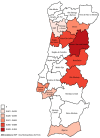Epidemiological and Clinical Aspects of Cutaneous and Mucosal Leishmaniases in Portugal: Retrospective Analysis of Cases Diagnosed in Public Hospitals and Reported in the Literature between 2010 and 2020
- PMID: 38674763
- PMCID: PMC11052487
- DOI: 10.3390/microorganisms12040819
Epidemiological and Clinical Aspects of Cutaneous and Mucosal Leishmaniases in Portugal: Retrospective Analysis of Cases Diagnosed in Public Hospitals and Reported in the Literature between 2010 and 2020
Abstract
Leishmania infantum, a zoonotic vector-born parasite, is endemic in the Mediterranean region, presenting mostly as visceral (VL), but also as cutaneous (CL) and mucosal leishmaniasis (ML). This study aimed to describe the epidemiological and clinical aspects of the CL and ML cases diagnosed in mainland Portugal between 2010 and 2020. Collaboration was requested from every hospital of the Portuguese National Health System. Cases were screened through a search of diagnostic discharge codes or positive laboratory results for Leishmania infection. Simultaneously, a comprehensive literature search was performed. Descriptive statistics and hypothesis testing were performed using IBM® SPSS® Statistics. A total of 43 CL and 7 ML cases were identified, with a predominance of autochthonous cases (86%). In CL, immunosuppressed individuals constituted a significant proportion of patients (48%), and in this group, disseminated CL (22%) and simultaneous VL (54%) were common. In autochthonous cases, lesions, mostly papules/nodules (62%), were frequently observed on the head (48%). The approach to treatment was very heterogeneous. ML cases were all autochthonous, were diagnosed primarily in older immunosuppressed individuals, and were generally treated with liposomal amphotericin B. The findings suggest a need for enhanced surveillance and reporting, clinical awareness, and diagnostic capacity of these forms of leishmaniasis to mitigate underdiagnosis and improve patient outcomes. A holistic One Health approach is advocated to address the multifaceted challenges posed by leishmaniases in Portugal and beyond.
Keywords: 2010–2020; Leishmania; Portugal; cutaneous; leishmaniasis; mucosal.
Conflict of interest statement
The authors declare no conflicts of interest.
Figures


References
-
- Farrar J., Garcia P., Hotez P., Junghanss T., Kang G., Lalloo D., White N. Manson’s Tropical Diseases. 24th ed. Elsevier; Amsterdam, The Netherlands: 2024.
-
- ECDC Surveillance, Prevention and Control of Leishmaniases in the European Union and Its Neighbouring Countries. Stockholm. 2022. [(accessed on 3 March 2024)]. Available online: https://www.ecdc.europa.eu/sites/default/files/documents/leishmaniasis-s....
-
- Gaspari V., Gritti T., Ortalli M., Santi A., Galletti G., Rossi A., Rugna G., Mattivi A., Matteo G., Belloli G.L., et al. Tegumentary Leishmaniasis in Northeastern Italy from 2017 to 2020: A Neglected Public Health Issue. Int. J. Environ. Res. Public Health. 2022;19:16047. doi: 10.3390/ijerph192316047. - DOI - PMC - PubMed
-
- Phlebotomine sandflies maps. European Centre for Disease Prevention and Control and European Food Safety Authority. Stockholm: ECDC. [(accessed on 3 March 2024)]. Available online: https://ecdc.europa.eu/en/disease-vectors/surveillance-and-disease-data/....
-
- Maia C., Dantas-Torres F., Campino L. The Leishmaniases: Old Neglected Tropical Diseases. Springer International Publishing; Cham, Germany: 2018. Parasite Biology: The Reservoir Hosts; pp. 79–106.
Grants and funding
LinkOut - more resources
Full Text Sources

